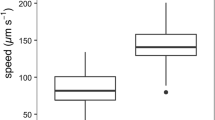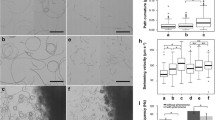Summary
The flagellar beat and swimming patterns of flagellated cells of 22 green plants, including 17 green flagellates (volvocalean and prasinophyte algae), motile cells of three seaweeds,Bryopsis, Caulerpa, andUlva, sperms of a liverwort,Marchantia, and a fern,Athyrium, were examined using a high-speed video system. So-called breast-stroke is widely distributed in green plants, and occurs rarely in prasinophyte flagellates and ulvophycean algae; in these algal groups flagellar beat similar to that found in animal sperm is common, both during forward and backward swimming. Different types of swimming patterns were observed in prasinophytes. The results indicate evolutionary trends of flagellar beat and swimming patterns in green plants such as change from backward to forward swimming, from flagellar to ciliary beating and from uni-directional (parallel) to radial-directional (cruciate) beating. Such trends are shown in two prasinophyte groups, thePyramimonas-lineage andTetraselmis-lineage.
Similar content being viewed by others
References
Belcher JH (1964) Further notes onScourfieldia caeca. Br Phycol Bull 2: 371–373
— (1969) Further observations on the type species ofPyramimonas (P. tetrarhynchus Schmarda) (Prasinophyceae): an examination by light microscopy, together with notes on its taxonomy. Bot J Linn Soc 62: 241–253
Boalch GT, Parke M (1971) The prasinophycean genera (Chlorophyta) possibly related to fossil genera, in particular the genusTasmanites. In: Farinacci A (ed) Proceedings of the 2nd Planktonic Conference, Rome 1970, pp 99–105
Brokaw CJ, Luck DJL (1983) Bending patterns ofChlamydomonas reinhardtii flagella 1. Wild type bending patterns. Cell Motil 3: 31–150
— —, Huang B (1982) Analysis of the movement ofChlamydomonas flagella: the function of the radial-spoke system is revealed by comparison of wild-type and mutant flagella. J Cell Biol 92: 722–732
Greuel BT, Floyd GL (1985) Development of the flagellar apparatus and flagellar orientation in the colonial green algaGonium pectorale (Volvocales). J Phycol 21: 358–371
Holwill MEJ, Sleigh MA (1967) Propulsion by hispid flagella. J Exp Biol 47: 267–276
Hoops HJ (1984) Somatic cell flagellar apparatuses in two species ofVolvox (Chlorophyceae). J Phycol 20: 20–27
—, Floyd GL (1983) Ultrastructure and development of the flagellar apparatus and flagellar motion in the colonial green algaAstrephomene gubernaculifera. J Cell Sci 63: 21–41
Hori H, Satow Y, Inouye I, Chihara M (1990) Origins of organelles and algae evolution deduced from 5S ribosomal RNA sequence. In: Nardon P, Gianinazzi-Pearson V, Grenier AM, Margulis L, Smith DC (eds) Endocytobiology, IV. INRA Press, Paris, pp 557–559
Hyams JS, Borisy GG (1978) Isolated flagellar apparatus ofChlamydomonas: characterization of forward swimming and alteration of waveform and reversal of motion by calcium ions in vitro. J Cell Sci 33: 235–253
Inouye I, Pienaar RN (1984) Light and electron microscope observations onNephroselmis astigmatica sp. nov. (class Prasinophyceae). Nord J Bot 4: 409–423
—, Hori T, Chihara M (1990) Absolute configuration analysis of the flagellar apparatus ofPterosperma cristatum (Prasinophyceae) and consideration of its phylogenetic position. J Phycol 26: 329–344
Kamiya R, Hasegawa E (1987) Intrinsic difference in beat frequency between the two flagella ofChlamydomonas reinhardtii. Exp Cell Res 173: 299–304
Manton I (1975) Observations on the microanatomy ofScourfieldia marina Throndsen andScourfieldia caeca (Korsch.) Belcher et Swale. Arch Protistenk 117: 358–368
—, Rayns DG, Ettl H, Parke M (1965) Further observations on green flagellates with scaly flagella: the genusHeteromastix Korshikov. J Mar Biol Assoc UK 45: 241–255
Melkonian M (1982 a) Structural and evolutionary aspects of the flagellar apparatus in green algae and land plants. Taxon 3: 255–265
— (1982 b) Effect of divalent cations on flagellar scales in the green flagellateTetraselmis cordiformis. Protoplasma 111: 221–233
— (1983) Functional and phylogenetic aspects of the basal apparatus in algal cells. J Submicrosc Cytol 15: 121–125
— (1984) Flagellar apparatus ultrastructure in relation to green algal classification. In: Irvine DEG, John DM (eds) Systematics of the green algae. Academic Press, ondon, pp 73–120
— (1990 a) Phylum Chlorophyta class Prasinophyceae. In: Margulis L, Chapman DJ, Corliss J, Melkonian M (eds) Handbook of Protoctista. Jones and Bartlett, Boston, pp 600–607
— (1990 b) Chlorophyte orders of uncertain affinities. Order Pedinomonadales. In: Margulis L, Chapman DJ, Corliss J, Melkonian M (eds) Handbook of Protoctista. Jones and Bartlett, Boston, pp 649–651
— Preisig HR (1982) Twist of central pair microtubules in the flagellum of the green flagellateScourfieldia caeca. Cell Biol Int Rep 6: 269–277
— — (1986) A light and electron microscopic study ofScherffelia dubia, a new member of the scaly green flagellates (Prasinophyceae). Nord J Bot 6: 235–256
— —, Robenek H (1984) The eyespot apparatus of flagellated green algae: a critical review. In: Round FE, Chapman DJ (eds) Progress in phycological research, vol 3. Biopress, Bristol, pp 193–268
Moestrup Ø (1978) On the phylogenetic validity of the flagellar apparatus in green algae and other chlorophyll a and b containing plants. Bio-Systems 10: 117–144
— (1983) Further studies ofNephroselmis and its allies (Prasinophyceae). I. The question of the genusBipedinomonas. Nord J Bot 3: 609–627
—, Ettl H (1979) A light and electron microscopical study ofNephroselmis olivacea Stein (Prasinophyceae). Opera Bot 49: 2–39
—, Hori T (1989) Ultrastructure of the flagellar apparatus inPyramimonas octopus (Prasinophyceae). 2. Flagellar roots, connecting fibers, and numbering of individual flagella in green algae. Protoplasma 148: 41–56
—, Throndsen J (1988) Light and electron microscopical studies onPseudoscourfieldia marina, a primitive scaly green flagellate (Prasinophyceae) with posterior flagella. Can J Bot 66: 1415–1434
— (1980) Prasinophytes. In: Cox ER (ed) Phytoflagellates. Elsevier/North Holland, New York, pp 85–145
O'Kelly CJ, Floyd GL (1984) Flagellar apparatus absolute orientations and the phylogeny of the green algae. Bio-Systems 16: 227–251
Omoto CK, Brokaw CJ (1985) Bending patterns ofChlamydomonas flagella 2. Calcium effects of reactivatedChlamydomonas flagella. Cell Motil 5: 53–60
Parke M (1966) The genusPachysphaera (Prasinophyceae). In: Barnes H (ed) Some contemporary studies in marine science. Allen and Unwin, London, pp 555–563
—, Adams I (1961) ThePyramimonas-like motile stage ofHalosphaera viridis Schmitz. Bull Res Counc Israel 10: 94–100
Pringsheim EG (1946) Pure culture of algae. Cambridge University Press, London
Ringo DL (1967) Flagellar motion and fine structure of the flagellar apparatus inChlamydomonas. J Cell Biol 33: 543–571
Rüffer U, Nultsch W (1985) High-speed cinematographic analysis of the movement ofChlamydomonas reinhardtii. Cell Motil 5: 251–263
— — (1987) Comparison of the beating of cis and trans-f1agella ofChlamydomonas cells held on micropipettes. Cell Motil Cytoskeleton 7: 87–93
Schmidt JA, Eckert R (1976) Calcium couples flagellar reversal to photostimulation inChlamydomonas. Nature 262: 713–715
Sleigh MA (1964) Flagellar movement of the sessile flagellatesActinomonas, Codonosiga, Monas andPoteriodendron. Q J Microsc Sci 105: 405–414
Sleigh MA (1981) Flagellar beat patterns and their possible evolution. Bio-Systems 14: 423–431
—, Barlow DI (1982) How are different ciliary beat patterns produced? Symp Soc Exp Biol 35: 139–157
Stewart KD, Mattox KR (1978) Structural evolution in the flagellated cells of green algae and land plants. Bio-Systems 10: 145–152
— —, Chandler CD (1974) Mitosis and cytokinesis inPlatymonas subcordiformis, a scaly green monad. J Phycol 10: 65–79
Tappan H (1980) The paleobiology of plant protists. WH Freeman, San Francisco
Throndsen J (1969) Flagellates of Norwegian coastal waters. Nytt Mag Bot 16: 161–216
Throndsen J (1988)Cymbomonas Schiller (Prasinophyceae) reinvestigated by light and electron microscopy. Arch Protistenk 136: 327–336
Author information
Authors and Affiliations
Rights and permissions
About this article
Cite this article
Inouye, I., Hori, T. High-speed video analysis of the flagellar beat and swimming patterns of algae: possible evolutionary trends in green algae. Protoplasma 164, 54–69 (1991). https://doi.org/10.1007/BF01320815
Received:
Accepted:
Issue Date:
DOI: https://doi.org/10.1007/BF01320815




